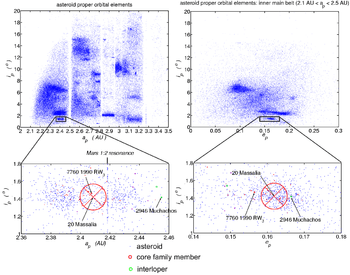Massalia family
The Massalia or Massalian family of asteroids is a grouping of S-type asteroids in the inner main belt at very low inclination. About 0.8% of known asteroids belong to this family.
Characteristics

This is a definite cratering family consisting of 20 Massalia and a mass of small fragments excavated from Massalia's surface by an impact. Massalia is by far the largest member with a diameter of about 150 km, while the next largest body, (7760) 1990 RW3 is only about 7 km in diameter. The mass of all the small members is negligible, less than about 1%, compared to Massalia.
The family is fairly young, estimated to have been created by an impact 150 to 200 million years ago. It has a distinctly two-lobed appearance in proper a--e space, with one lobe centered at semi-major axes of 2.38 AU, the other at about 2.43 AU, with the parent body Massalia itself located in between. The bodies in the lobes tend to be smaller on average than those in the central region. It has been shown that this structure is likely caused by slow drift of the semi-major axis caused by the Yarkovsky and YORP effects. Details of the lobes were used to calculate the age of the family.[1]
A strong 1:2 orbital resonance with Mars crosses the family at 2.42 AU, and appears responsible for some "leakage" of family members away from the area into higher inclination orbits.[1]
The Massalia family or a recent minor collision within it may be the source for the prominent α dust band, the other candidate being a recent collision within the Themis family.[1][2]
Location and size
The Massalian asteroids are located at very low inclinations, straddling the 1:2 resonances with Mars.
A HCM numerical analysis by Zappalà et al.[3] determined a group of 'core' family members, whose proper orbital elements lie in the approximate ranges
| ap | ep | ip | |
|---|---|---|---|
| min | 2.37 AU | 0.143 | 1.2° |
| max | 2.45 AU | 0.175* | 1.75° |
- * The Zappalà core members only reach e=0.170 but inspection of more modern proper elements reveals that the family extends at least to e=0.175
At the present epoch, the range of osculating orbital elements of these core members is
| a | e | i | |
|---|---|---|---|
| min | 2.37 AU | 0.124 | 0.4° |
| max | 2.45 AU | 0.211 | 2.35° |
The Zappalà 1995 analysis found 42 core members, while a search of a recent proper element database[4] for 96944 minor planets in 2005 yielded 761 objects lying within the rectangular-shaped region defined by the first table above. This would give about 0.8% of all main belt asteroids.
list
| Name/designation | Number | Proper semimajor axis (AU) | Proper inclination (degrees) | Proper eccentricity | diameter (km) | Group |
|---|---|---|---|---|---|---|
| Massalia | 20 | 2.409 | 1.421 | 0.162 | 150 (measured) | Primary member |
| Muchachos | 2946 | 2.455 | 1.417 | 0.166 | 9 (estimated) | Interloper |
| Puccini | 4579 | 2.400 | 1.392 | 0.163 | 8 (estimated) | Core member |
| Rameau | 4734 | 2.416 | 1.359 | 0.164 | 5 (estimated) | Core member |
| Švejcar | 5031 | 2.436 | 1.535 | 0.148 | 7 (estimated) | Interloper |
| Hessen | 5846 | 2.435 | 0.913 | 0.163 | 5 (estimated) | Interloper |
| 1990 RW3 | 7760 | 2.407 | 1.465 | 0.156 | 9 (estimated) | Core member |
Interlopers
A number of interlopers have been identified, which share the same orbital elements as the true family members, but cannot have come from the same cratering event because of spectral (hence, compositional) differences. 2946 Muchachos and some other bodies were noted as interlopers during a detailed study of the family,[1] while 2316 Jo-Ann is seen to have the wrong spectrum by inspection of the PDS asteroid taxonomy data set. Muchachos is larger than any of the true family members apart from Massalia itself.
References
- 1 2 3 4 D. Vokrouhlický; et al. (2006). "Yarkovsky/YORP chronology of asteroid families". Icarus. 182: 118. Bibcode:2006Icar..182..118V. doi:10.1016/j.icarus.2005.12.010.
- ↑ D. Nesvorný; et al. (2003). "Recent origin of the solar system dust bands". The Astrophysical Journal. 591 (1): 486–497. Bibcode:2003ApJ...591..486N. doi:10.1086/374807.
- ↑ V. Zappalà, Ph. Bendjoya, A. Cellino, P. Farinella and C. Froeschlé (August 1995). "Asteroid Families: Search of a 12,487-Asteroid Sample Using Two Different Clustering Techniques". Icarus. 116 (2): 291–314. Bibcode:1995Icar..116..291Z. doi:10.1006/icar.1995.1127.
- ↑ "Proper elements for 96944 numbered minor planets". AstDys site. Retrieved 2006-05-09.